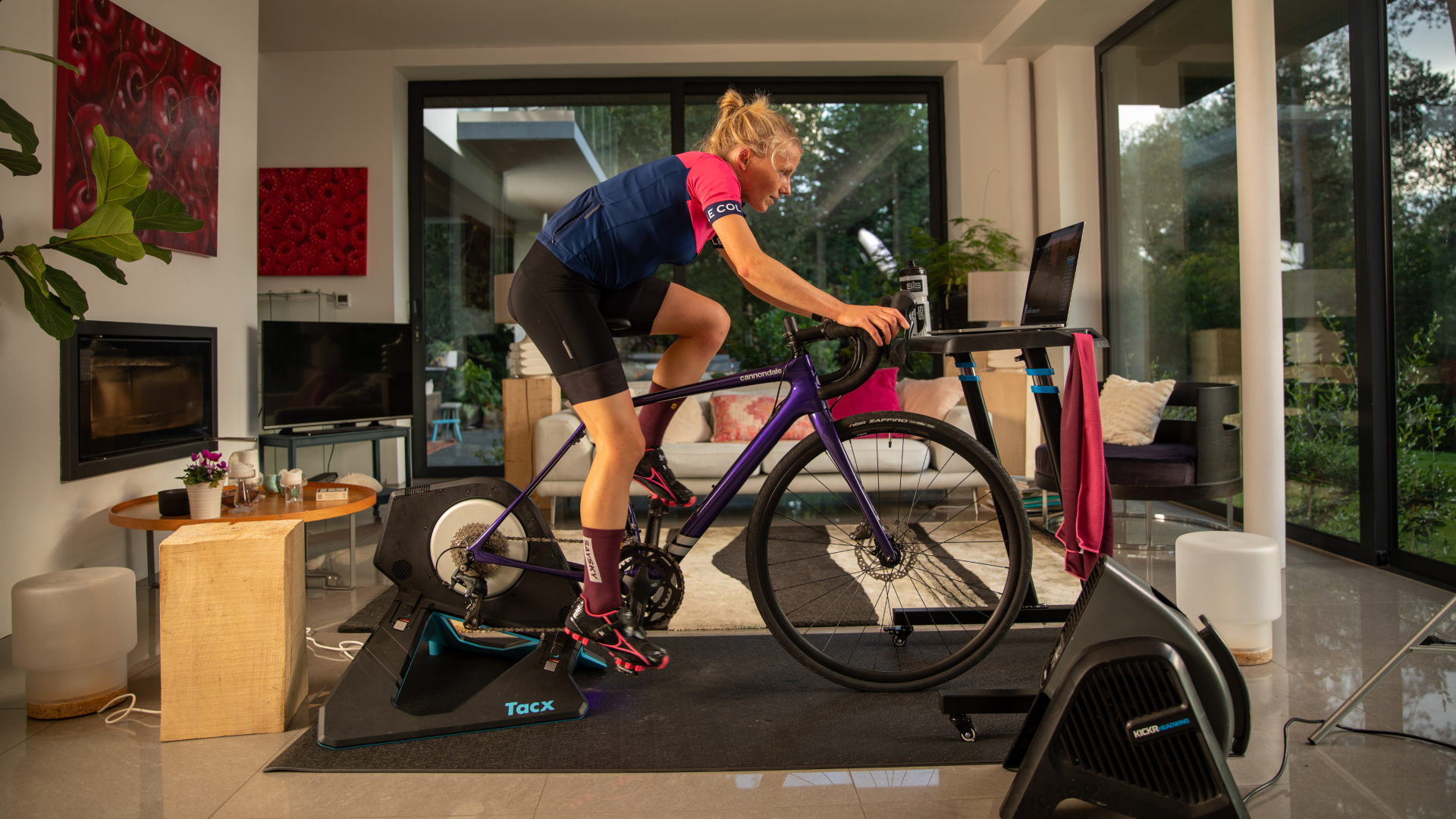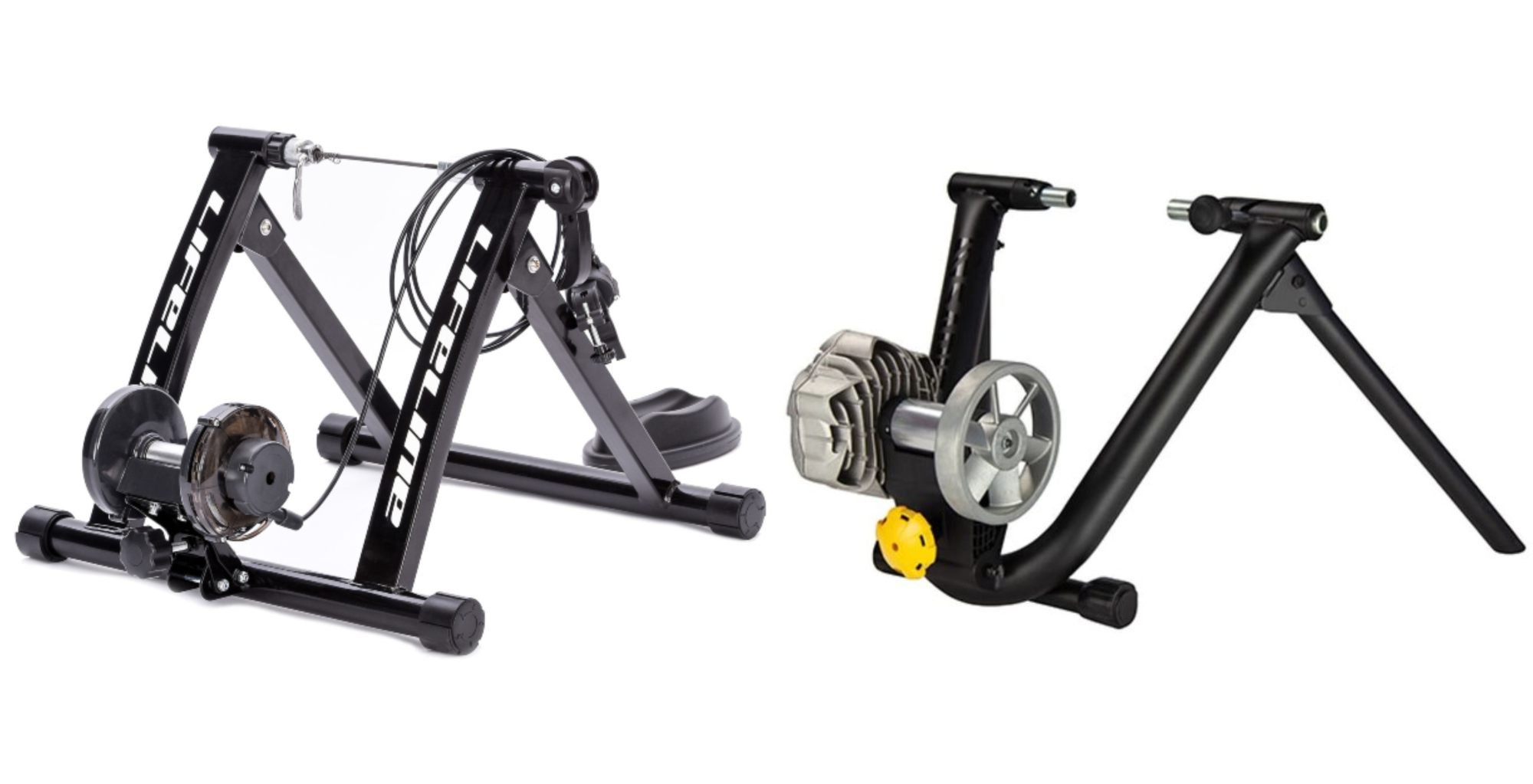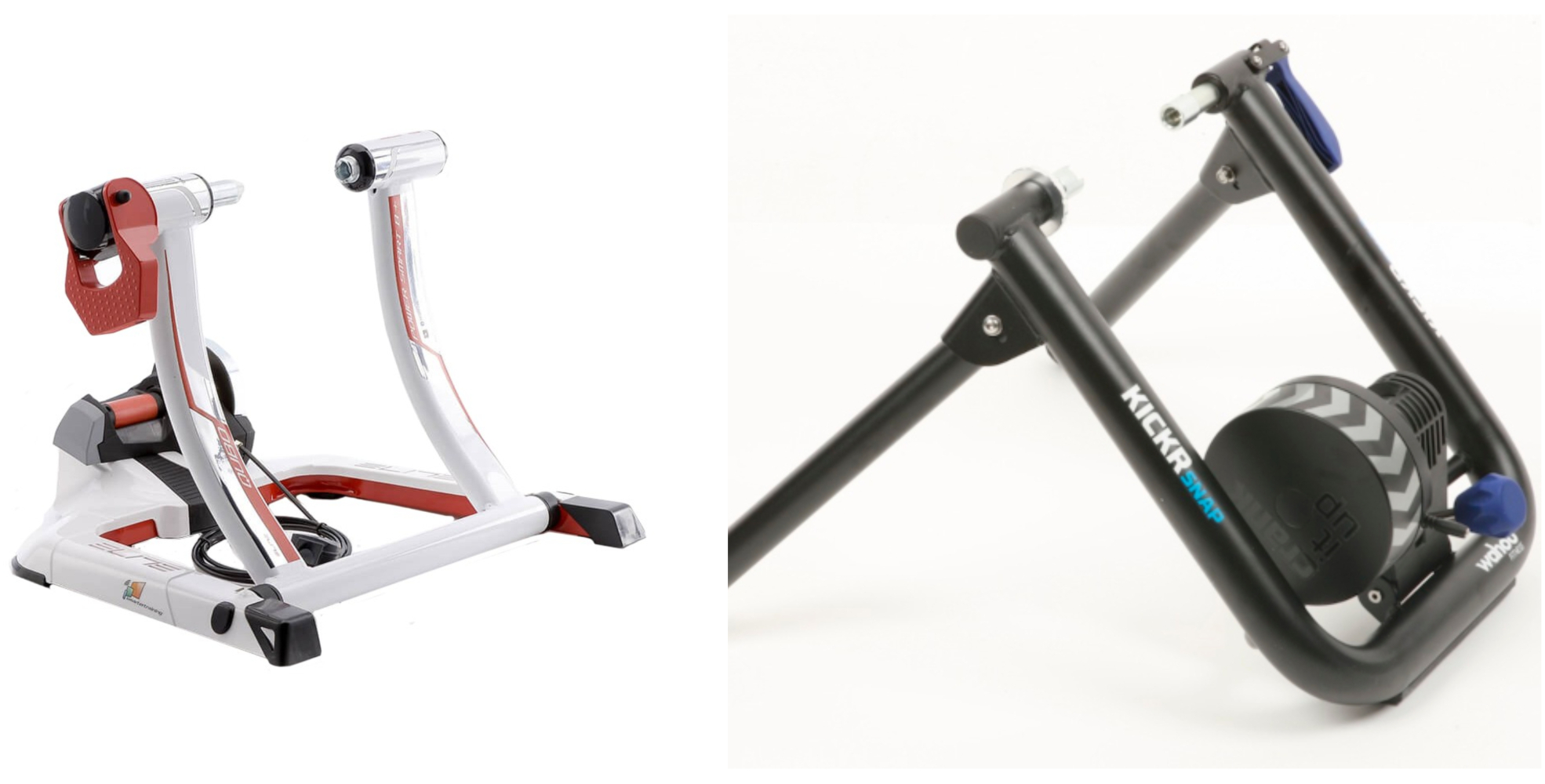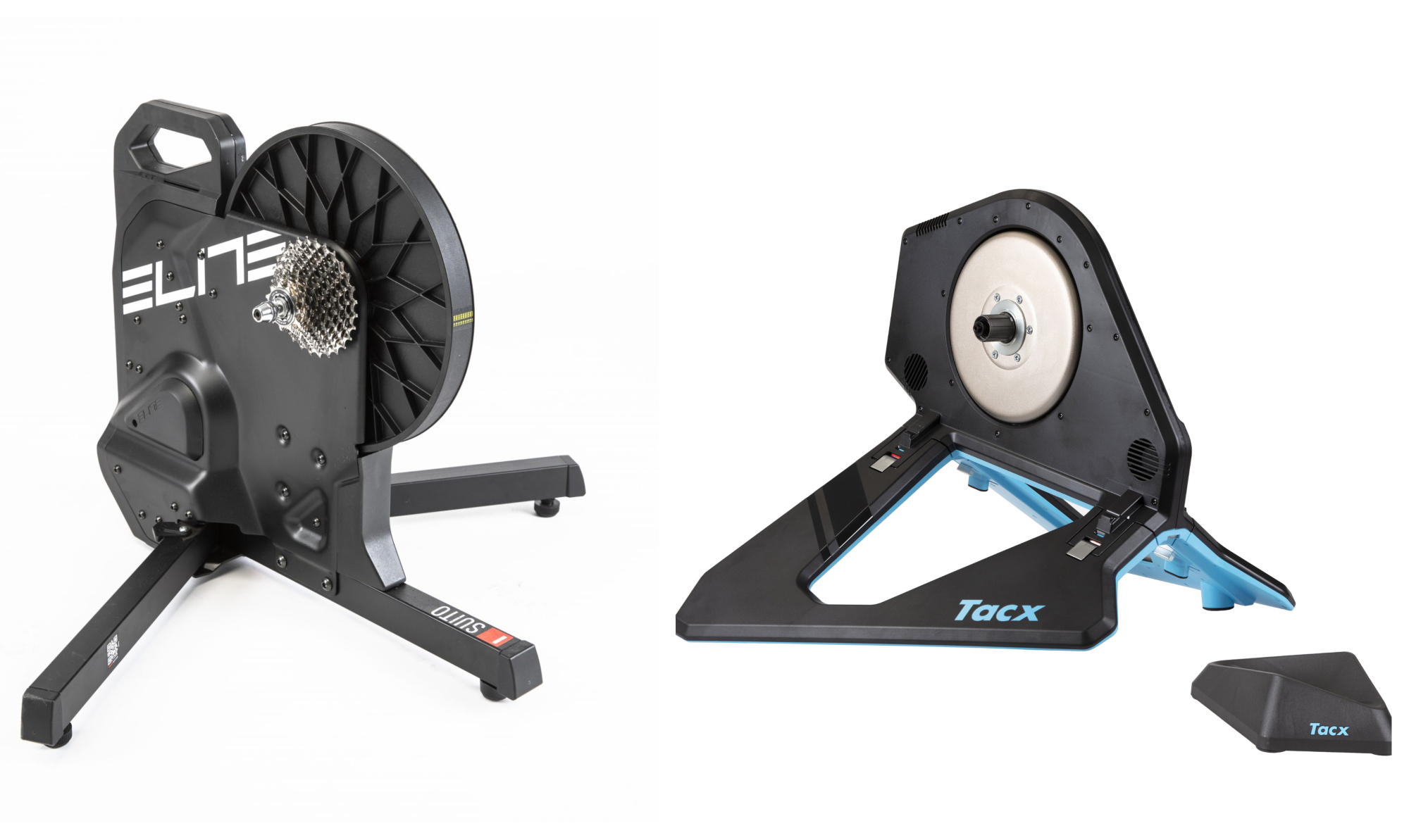Cheap versus expensive turbos trainers: are you paying four figures for features you don’t need?
Today's turbo trainers are available at a myriad of price points but what are the differences between entry level and top-tier units? We take a look at the details and their impact on the experience of riding indoors

Before the birth of direct drive smart trainers and third-party interactive apps, training indoors was simply a means to an end. When the weather turned grim, cyclists would reluctantly head to their shed or garage and complete a few sessions, often staring blankly at the wall ahead while willing it all to be over. Retaining motivation over the winter months wasn’t helped by the turbo trainers themselves, which often lacked stability and created a racket, hence the need to be banished to an outhouse so family members could watch the television in peace.
Fortunately much has changed in recent years and indoor training is no longer reserved for sadists or indeed just the colder months. Indeed, for many cyclists, especially those who race, an indoor Zwift session or two forms part of their regular cycling week year round.
That said, even with the improvements to both hardware and software, indoor training can test your dedication to the cause. Put simply, unless it's bucketing down outside or a cold snap has left the local lanes resembling the Cresta Run, riding outdoors, for most, is bags more fun. Therefore a reliable turbo with a range of features is a must-have if you want to ride through the winter without losing your sanity.
If you’re new to the idea of training indoors a cursory glance at today’s turbos can be confusing given the wide choice. It can also potentially be off-putting considering the sky high prices of some of the best smart turbo trainers on the market.
However there are still a number of decent budget options available, enabling you to start training without breaking the bank. But what are the differences between the cheaper models and those all-singing, all-dancing machines which can have four figure price tags? Let’s look at some comparisons, detailing the differences between budget and expensive turbo trainers and how they might, or might not, impact the quality of your indoor cycling sessions.
Smart or classic?
The most significant change to indoor cycling in recent years has been the advent of smart trainers and the range of the best indoor training apps that allow you to race and train in the virtual world.
We have a dedicated page that details the cheapest way to connect to Zwift, one of the most popular virtual cycling apps, but it’s worth covering a little of this ground here.
The latest race content, interviews, features, reviews and expert buying guides, direct to your inbox!
Smart trainers are the ideal way to join the ‘fun’ of virtual training and racing. Not only do they have integrated power meters and cadence/speed sensors, they are also ‘interactive’ and will automatically replicate gradients and the effect of drafting when you’re racing as well adjusting resistance during power-based training efforts to ensure you’re hitting the right numbers.
But smart trainers are expensive, certainly when compared to their classic counterparts. Whether the additional cost is worthwhile will be down to your needs, and the flexibility of your budget, but if virtual racing is of serious interest then the investment is likely to be necessary.
However, you can enjoy Zwift and other apps using a traditional turbo trainer with a few add ons, namely a speed/cadence sensor or a power meter. Both can be used in the real world too, so they aren’t investments solely for indoor training. If you opt for the cheapest option of a traditional trainer with a cadence sensor your speed will be converted into watts via the app - Zwift’s virtual watts are called zPower, for example. It’s less accurate and virtual watts will usually see you DQ’d after you’ve completed a Zwift race.
Classic turbo trainers: Lifeline TT-01 vs Saris Fluid 2

The difference in price between these two trainers is pretty negligible. The Lifeline TT is a true entry-level model and can be bought for well under £100, while the Saris Fluid has a RRP of £299.99 but can be routinely found online for less than £150.
The Lifeline TT-01 uses magnetic resistance, with six levels available, offering up to 800w at the highest point, all controlled via a handlebar-mounted lever. It’s ideally suited for those on a tight budget as well as those who are a little tentative about joining the turbo world ; it allows you to dip your toes in the indoor training pond without any heavy financial implications if you find it's not for you. Other plus points include a classic A-frame design that’s easy to fold down and stow away as well as a design that accommodates wheel sizes from 26” to 700C.
So what do you get if you spend a little more? The Saris Fluid 2, as the name states, uses fluid resistance instead of magnetic. It translates to a smoother, and quieter, ride - 69 decibels at 20mph according to Saris. It also delivers up to 900w of added resistance. Perhaps the biggest selling point of the Saris though is that it can be purchased with a ‘smart kit’ - a speed and cadence sensor that will connect to a third-party training app using ANT+ and Bluetooth.
Wheel-on turbo trainers
A clear, and obvious, difference between models begins with how the bike attaches to the training unit. There are essentially two options here: wheel-on and direct drive.
Wheel-on means just that; you keep the rear wheel of your bike on and mount it to rollers using a quick-release system. Resistance is either magnetic, which is then manually adjusted, usually by a dial that’s mounted on the bike’s handlebars, or on more expensive models, fluid. This system uses a blade or propeller inside a liquid-filled chamber to produce gradual resistance, allowing the changing of your bike’s gears to impact the level of resistance.
The wheel-on system is certainly the go-to method for the cheapest turbo trainers but is also used on some more expensive models too. At the lower end of the spectrum prices start at under £100, while higher end models can retail for as much as £500. It’s a design that has its advantages, beyond the price itself, as well as its drawbacks.
A simple A-frame trainer is portable and easy to store given its capacity to fold away. This makes it a good choice if you want to bring your trainer to warm up and down at a race.
It’s also straightforward to set up given that your bike stays intact, especially so if it uses quick release skewers. If you’re after a fuss-free and affordable way to do a spot of indoor riding over the winter, and are happy to structure your workouts using manual resistance and perceived effort, then a basic, wheel-on turbo could well be the option for you.
Interestingly, more expensive wheel-on models are less portable, trading this functionality for improved stability, more resistance and a smoother ride, the latter two delivered via a larger, and heavier, flywheel.
The downsides to a wheel-on trainer are probably obvious. Firstly, given that the tyre is in contact with a roller it will wear down. You can buy turbo trainer tyres but this will mean having a dedicated wheel that you swap in and out of your bike when you train indoors. Suddenly, it's not quite as fuss-free.
If your bike is fitted with disc brakes and uses the modern thru-axles standard for securing the wheels in the dropouts, then you’re likely to have to buy an adapter to allow it to work with most wheel-on trainers. It’s not difficult to set-up but it does require additional expense.
A wheel-on trainer also has some performance limitations. Generally speaking the flywheels are fairly small on most of the cheaper trainers, which reduces the amount of added resistance they can deliver; around 600-800 watts is pretty typical for a decent wheel-on model but this number can be lower. If you’re a powerful rider this could prevent some problems and require you to use a more expensive wheel-on trainer such as the Wahoo Kickr Snap, which has a maximum power of 1500 watts.
The delivery of power can also be far less reliable and if you’re wanting to train by power, or another measurable such as cadence, you’re likely to need to use external sensors to track your data; there are smart wheel-on trainers like the Wahoo model mentioned above, but these are, naturally, more expensive than the budget models that don’t allow you to ‘plug in’. As mentioned in the ‘smart vs classic’ section, if you’re planning on entering virtual races then a smart model with an integrated power meter is close to essential.
While the A-frame makes the cheap wheel-on trainer eminently portable, it also means it’s often not the most secure, especially when under the stress of high-intensity and out of the saddle efforts. A rubber mat can negate some of this lateral movement but compared to more expensive wheel-on trainers and almost all direct-drive trainers they’re far less stable.
They can also be pretty noisy, certainly when compared again to the generally more expensive direct-drive models. If you’re planning on riding in the house, and riding often, this can be a real drawback. Even if you live alone, the noise of some wheel-on trainers might be enough to prompt complaints from the neighbours.
Wheel-on: Elite Qubo Power B+ vs Wahoo Kickr Snap

The popularity of direct-drive trainers means that the wheel-on market is perhaps more competitive than ever before. You can get a smart wheel-on model for well under £500, with the gap between ‘budget’ and ‘premium’ reduced as a result. The Elite Qubo Power B+ however has always been designed as an entry into the world of smart training. It uses magnetic resistance, with eight adjustable levels. There’s an integrated wireless speed sensor though, so it requires no add ons to connect with third-party apps like Zwift. The Qubo system also promotes a faff-free experience, with rider weight automatically setting the roller pressure.
Wahoo’s Kickr Snap has a RRP of close to £500 but in reality can now be purchased for far less. It offers 1,500w of resistance and a maximum simulated gradient of 12 per cent. Easily connected to third-party training apps, once there you’ll benefit from auto-resistance control plus power, speed and distance reading without requiring any additional sensors. Being part of the Kickr family means it can also be paired with add-ons such as the Wahoo Kickr Headwind Smart fan and Kickr climb.
Direct-drive turbo trainers
So how does a direct-drive trainer stack up in comparison?
A direct-drive loses the back wheel and sees the bike frame attached directly to the unit at the dropouts, which is fitted with a cassette that matches your chain and corresponding groupset. It’s a design that allows for a bigger, sturdier unit, which usually translates to a smoother, and more accurate ride.
Both flat-out sprints and sustained efforts at a higher power are both aided by the additional weight of a direct-drive over a wheel-on trainer. The transference of power is more efficient too, eliminating the wheel slippage that can occur due to the rollers used on a wheel-on turbo. The larger flywheel used in these trainers makes for a more realistic riding experience, while the lack of a rear wheel ensures that its a quieter ride too, when compared to a wheel-on affair. As for the amount of added resistance you can expect from a direct-drive trainer, it will range between 1,500 watts for cheaper models up to 3,500+ watts for a top-tier machine. Even if you're Chris Hoy in the making, this should provide all the resistance you need.
All of these benefits come with a major disadvantage, and that’s the cost. Direct-drive trainers can be more than twice the price, or more, compared to wheel-on models. If cost is your only concern then a wheel-on trainer will win every time, but you’ll have to accept its limitations, especially if you're opting for a cheaper model.
The size of a direct drive unit can also be an issue if you’re pushed for space at home and need to put away your trainer after each session. They are far better suited to those fortunate to have a dedicated training room where it can be left in situ.
Direct-drive: Elite Suito vs Tacx Neo 2T

Elite’s Suito is affordable - less than £600 if you shop around - but does come with some limitations when compared to pricer options. Its maximum resistance is 1,900w; plenty for most but less than many of its competitors. It’s also a little less accurate, with its power readings +/- 2.5 per cent; top-tier direct-drive models are likely to have a number under 1 per cent. But there’s plenty to like here. It’s a solidly built machine, making it well-suited to hard efforts. The supports are adjustable too, so even if your floor is off-kilter, your riding experience won’t be. It also delivers a smooth and realistic ride feel and will simulate gradients up to 15 per cent.
If you’re after a turbo that’s designed to replicate riding on the road, Tacx’s Neo 2T is likely to fit the bill. It offers a maximum resistance of 2,200w and is able to simulate gradients of up to 25 per cent - both numbers should be plenty for even the most competitive of cyclists. It also boasts side-to-side movement when out the saddle and a flywheel that’s designed to simulate descending. It’s also easy to set up out of the box and is one of the quieter trainers on the market. The downsides, other than the four-digit price tag? It doesn’t come with a pre-installed cassette and is close to impossible to move around once the bike is in place.
Luke Friend has worked as a writer, editor and copywriter for over twenty five years. Across books, magazines and websites, he's covered a broad range of topics for a range of clients including Major League Baseball, Golf Digest, the National Trust and the NHS. He has an MA in Professional Writing from Falmouth University and is a qualified bicycle mechanic. He has been a cycling enthusiast from an early age, partly due to watching the Tour de France on TV. He's a keen follower of bike racing to this day as well as a regular road and gravel rider.